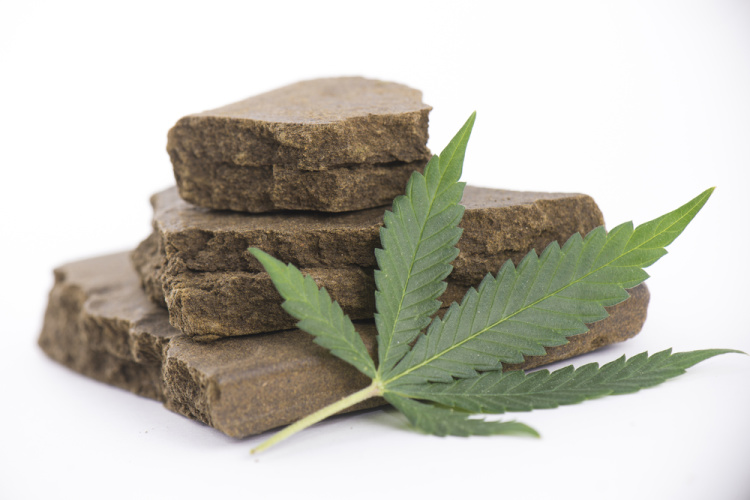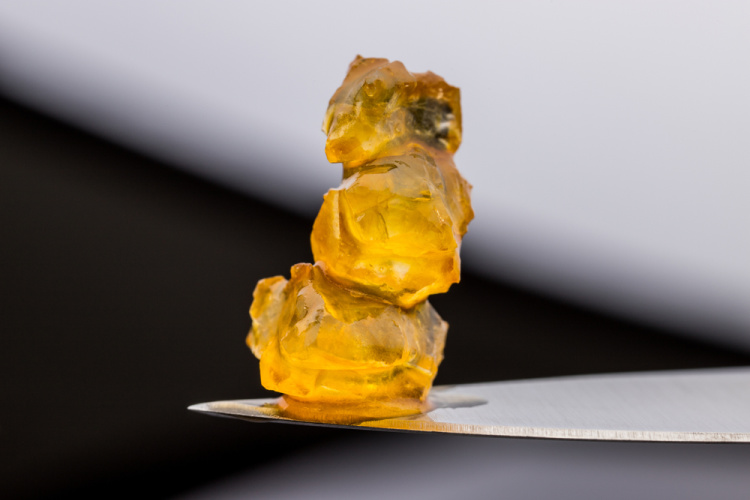Out of all the products lining our dispensary shelves today, few inspire as much excitement and wonder as cannabis concentrates. They span nearly every consistency, texture, and flavor profile possible and offer incredible potency levels to boot—even compared with the strongest THC flower.
If you’re new to this exciting corner of the cannabis world, you may have a few questions. What exactly are concentrates? What are the best methods for consuming them? Are extracts and concentrates the same thing?
Take a deep dive with us and get all your burning questions answered. By the end of this post, you’ll be ready to load up your rig and start sampling some quality concentrates.
What Are Cannabis Concentrates?
Since the late 1990s, cannabis concentrates—sometimes called extracts—have become one of the most exciting and ground-breaking sectors of the cannasphere. While they can take many forms, they’re all produced by extracting and then concentrating the cannabinoids THC or CBD—and sometimes the aromatic oils called terpenes—from the cannabis flower. THC is the best-known cannabinoid responsible for the bulk of the plant’s signature effects.
How concentrated are we talking? While the most potent flower tests in the 30% THC range, concentrates can easily exceed 90% THC, making them the hardest-hitting cannabis products available anywhere.
They’ve also been a staple throughout history, with hash and kief being the ancient ancestors of all modern concentrates. These two product types are produced using very simple methods, but in recent years, hi-tech extraction methods have allowed cutting-edge producers to create new types of concentrates that can capture the essence and complexity of the cannabis plant in ways we never thought possible.

Solvent-based vs Solventless Extraction Methods
There are many ways to categorize the various types of cannabis concentrates, but for many people, the most critical question is whether or not the product was created using a solvent-based or solventless extraction method.
- Solvent-based: Concentrate products that employ varying chemical compounds to separate the physical material of the cannabis plant—flower, stems, and other plant matter—from the cannabinoids and terpenes. Typical solvents used for the process are CO2, butane, or propane, which are purged from the final product.
- Solventless: Solventless concentrates use other methods for removing cannabinoids and terpenes from plant material. They can be mechanically separated, as with agitation for example, or they can be separated with heat and pressure, which work together to remove trichomes—the tiny mushroom-like glands that contain the bulk of cannabinoids and terpenes—from the cannabis flower.
Solvent-based extracts are popular for their versatility—the method can produce various consistencies, from budder to wax to shatter. However, working with solvents requires skill, care, and experience with laboratory-grade equipment. As a result, solvent-based extraction should only be attempted by professional extractors in a controlled environment, and you should always check the Certificate of Analysis (COA) before purchasing solvent-based products.
The Difference Between Extracts and Concentrates
One of the most confusing points regarding cannabis concentrates is the divide between “concentrates” and “extracts.” While the terms are often used interchangeably, they’re not quite the same thing.
- Extracts are created by removing—that is, extracting—the active cannabinoids and terpenes from cannabis flower through the solvent-based or solventless extraction methods mentioned above.
- Concentrates is a broader term that includes extracts, but it really applies to any potent, concentrated cannabis product, including kief, a simple concentrate made of separated, dried trichomes or hashish, an ancient concentrate made by pressing separated trichomes.
It’s like this: All extracts are concentrates, but not all concentrates are extracts.
Types of Cannabis Concentrates
The world of concentrates is limited only by the imagination, and some new and exciting products are always hitting the market. However, it can be hard to differentiate between so many options, so we rounded up some of the most popular styles and types of cannabis concentrates that you can find at your local dispensary today.
Kief and Hash
While concentrated THC products might seem like a modern invention, two concentrates date back centuries: kief and hash. Kief is made of the sifted and dried trichomes of the cannabis flower; it takes a sandy, grain-like form. When it’s pressed into chalky blocks, it’s known as hash, an elegantly simple and time-honored form of cannabis concentrate.
Shatter
A popular solvent-based extract, shatter takes the form of dried, translucent candy-like shards of cannabis concentrate.
Batter and Budder
Both batter and budder are creamy and smooth, resembling cake batter. Both add a smooth boost of flavor and potency when dabbed or added to flower. However, they’re less shelf-stable than other concentrates and can lose their creamy consistency and bright appearance over time. They should be stored in sealed, light proof containers away from excessive heat or cold.
Live Resin
A type of solvent-based cannabis concentrate made from flash-frozen cannabis flower, the method of making live resin preserves an extremely high proportion of terpenes.
THC Wax
These soft and opaque cannabis concentrates are meant to be consumed in a dab rig or added to a joint or bowl for a big dose of potency and flavor.
Rosin
Not to be confused with resin, rosin is a form of solventless concentrate made using mild heat and pressure. Its purity and flavor profile make it one of the most popular solventless concentrates we offer.
Live Rosin
Just as live resin is a solvent-based extract made from flash-frozen, just-picked cannabis flower, you can think of live rosin as its solventless cousin. Live rosin is made just like rosin, with gentle heat and pressure, but live rosin boasts brighter and fresher flavors and aromas as compared to rosin.
RSO
RSO stands for “Rick Simpson Oil,” named after the Canadian medical cannabis cultivator and activist who used cannabis during his bout with cancer. Many patients use RSO to help ease chronic symptoms.
Distillate
Climbing in popularity, distillate contains pure cannabinoids in liquid form. It lacks the characteristic cannabis flavor of other extracts, making it a great option for making edibles, and it’s often used in vape cartridges.
THCA Diamonds
Diamonds contain nearly pure THCA, the precursor cannabinoid to THC. They can be clear or amber-colored, and when they’re exposed to heat from a dab rig or vaporizer, they decarboxylate and instantly transform into an incredibly potent product.
Resin Sauce
Made from THCA diamonds suspended in “terp sauce,” resin sauce is a highly flavorful and terpene-rich liquid extract. Because of its unique consistency, it must be consumed using equipment that can handle liquid or semi-liquid concentrates.
Moon Rocks
These potent nugs are three products in one, in which chunks of flower get dipped in hash oil and then rolled in kief. They’re more suited for bowls or bongs than a specialized rig.

How to Consume Cannabis Concentrates
Concentrates can be consumed in several ways, and the best choice for you will depend on the experience you want to have. Here are three of the most popular ways to consume cannabis concentrates.
Dab Rigs
Many concentrates work perfectly with a dab rig, a high-tech variation on a standard bong or water pipe. Operating them isn’t challenging in and of itself, but there’s often a learning curve—while some dab rigs incorporate an electric heating element, others require a hand-held butane torch.
To use a dab rig, you heat the bottom of the “nail,” a small glass chamber that holds and vaporizes your concentrates. When the nail is up to temperature, drop in your concentrates, then inhale the vapor from the mouthpiece. Check out our guide to dabbing.
Joints or Bowls
Particularly easy-to-work concentrates like kief or hashish can be added to the ground flower in your joints or bowls, bumping up both flavor and potency. You can choose to mix your concentrates with ground flower, sprinkle them on top of bowls, or even roll them around your pre-rolls and joints if they’re sticky enough. Concentrates such as hash oil are also considered the secret ingredient in infused pre-rolls.
Vaporizers
There are lots of different vaporizing devices available for vaporizing cannabis flower and concentrates. If you want to vape concentrates like badder, wax or rosin, you’ll need a device made for cannabis concentrates specifically. Operating a vaporizer that can take cannabis concentrates is pretty simple. Usually, they only require the push of a button or an intake of air to fire the heating element. However, these units require regular cleaning and maintenance to ensure they don’t get clogged by resin from melted concentrates.
Tips and Best Practices When Consuming Cannabis Concentrates
When you start experimenting with cannabis concentrates, it pays to take things slow. Consuming any form of THC introduces the potential for adverse side effects, and when consuming cannabis concentrates, the very high potency increases this possibility even more. The side effects of accidentally consuming too much cannabis can include:
- Dizziness
- Nausea
- Anxiety
- Paranoia
- Impaired perception or body movements
When you’re first getting the hang of things, remember this popular catchphrase in the cannabis world: Start low, and go slow. While consuming too much THC is rarely dangerous, it can be unpleasant, and that’s something we’d like to help you avoid!
Explore the World of Concentrates with Green Goods
Potent, fast-acting, and flavorful, cannabis concentrates are among the most popular class of cannabis products available. With a variety of potencies, textures, flavors and aromas out there, cannabis concentrates are among the most varied and popular products we carry at our family of dispensaries.
If you’re interested in how to use cannabis concentrate or other concentrate-related topics, you’re in the right place! Learn all about dabbing THC, untangle the differences between rosin and resin, and go even deeper at our cannabis blog.
Have any other questions about cannabis concentrates or other cannabis-related topics? Just ask one of our friendly budtenders or drop us a line. We’re always here to help!
